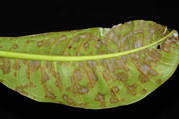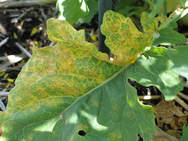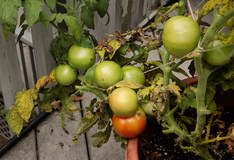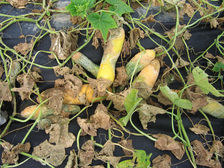|
Ozark Green Thumb BCMG Monthly e-Newsletter |
|
|
 Disease is a general term that can include fungal, bacterial and viral pathogens. All three of these pathogens can lay dormant until favorable conditions present themselves. This can be related to temperature, moisture or plant health. Many of the diseases we encounter in the South favor hot and humid conditions. It is important to identify whether you are dealing with fungal, bacterial or viral pathogens. The control for each of these is completely different. This a list of potential disease problems you may encounter in your garden.  POWDERY MILDEW This disease can attack everything from trees and shrubs to vegetables. It appears as a gray-like powder on the tops of leaves. It is one of the only fungal disease problems that favors dry weather. It is most common in late spring and early fall. Powdery mildew can be controlled by spraying approved fungicides at 10 to 14 day intervals.  FUSARIUM WILT This another fungal pathogen that attacks a broad range of plants, including ornamentals and vegetables. This fungus occurs in the soil and penetrates the roots of the plant, working its way into the vascular system. It begins to clog up the plants "plumbing" causing leaves to turn yellow and stems to wilt. Treatment is very difficult once the plant is infected. Vegetable plants normally will die and need to be removed.  SEPTORIA LEAF SPOT AND SPOT ANTHRACNOSE These are two very common diseases that can be caused by either bacterial or fungal pathogens. Correct identification will be needed when selecting a control. Many times affected leaves can simply be plucked off and discarded. On larger shrubs and trees, the disease tends to be more of a cosmetic issue and the plant can normally survive.  BACTERIAL WILT Bacterial wilts are caused by several different strands of bacteria and can affect vegetables, flowers, and other herbaceous plants. This disease can be transmitted through infected soil or through insects feeding on infected plants and transmitting to healthy plants. Bacteria cause a disruption in the vascular system of plants causing them to discolor, wilt, and eventually die. Once bacteria enter into the plant, it is almost impossible to control. Discard infected plants and keep damaging insects under control to help with the spread of disease. Fumigation or solarization of the soil my be an effective way to control the disease for future crops.  FIRE BLIGHT This disease is actually a bacterium that is very host specific and affects members of the rose family. This includes pears, apples, crabapples, hawthorn, and Pyracantha. The disease is fed by insects feeding on the plants and is most active in late spring during warm, humid weather. Infected branches wilt and turn brown and then black as if scorched by fire. Spraying for this disease can be tricky depending upon the height of the plant or tree. Once infected, prune the damaged branches down several inches into the good wood. Remove the cut branches from the site. VIRUSES There are many viruses that can affect anything from ornamentals to fruit trees and vegetables. Viruses normally cause discoloration or mottling of leaves. Leaves and branches are often deformed and twisted and leaves may appear elongated or tiny. Insects, soil or moisture can carry or spread viruses. There are no effective controls so cutting damaged areas out and plant removal are the only remedies. DAMPING OFF This disease is caused by several species of fungi and is common in our Southern soils. It is one of the main causes of poor germination of vegetables and annual flowers. Seedlings are very susceptible when they first emerge. This disease is most prevalent in high-nitrogen soils that stay consistently wet. Plant seeds in well-amended and well-drained sites to minimize the chance of infection. Do not add high-nitrogen fertilizers until seedlings have grown several sets of leaves. Fungicide-coated seed can also discourage damping -off.  PHYTOPHTHORA AND PYTHIUM ROOT ROT Both of these fungi thrive in wet, poorly drained soils. They can attack the roots and stems of plants causing them to rot and eventually die. Gardeners frequently mistake the wilting for drought stress. Often individual plant branches die first and then the overall plant turns yellow and eventually dies. Prevent this disease by planting only in well drained areas. Water plants only when necessary and allow soil to dry out between irrigations. This short list of disease problems are only a handful of what is actually out there, but these are definitely some of the most common ones you may encounter. Careful plant selection and good cultural practices will go along way toward keeping your plants healthy and avoiding these potential killers. Excert from
"THE BEATEN PATHOGEN" By Bob Westerfield Arkansas Gardener October 2015
1 Comment
11/14/2021 12:39:57 am
Very informative. Also, glad you also included some remedies and/or prevention for these plant diseases. Like what you've said, these are just "a handful of what is actually out there" but these are great start. Really helpful since I'm researching on plant diseases. Thank you for sharing.
Reply
Leave a Reply. |
Archives
April 2022
|
|
